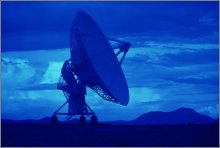Space Power as An Alternate Energy Source for Earth?
by www.SixWise.com
As the United States and other nations scramble for alternative
sources of energy that can outdo expensive, and limited,
coal and oil, the Pentagon has backed a solution that is,
literally, out of this world: space-based solar power.
|

Scientists have envisioned antennas that are three
miles by six miles wide that could capture limitless
energy from space.
|
The idea is not exactly new. NASA and Japanese and European
space agencies have been exploring it since the 1960s, trying
to figure out how to harness the extreme power of solar energy,
which is eight times stronger in outer space than it is when
it reaches Earth.
Now, the Defense Department released a 75-page study for
its National Security Space Office that found space power
could be utilized with available technology, except that the
process is currently not cost-effective.
Space power would be collected by massive solar panels onboard
satellites. The energy captured would then be converted into
microwaves and transmitted to Earth, where it would become
direct-current electricity.
However, thousands of tons of equipment would need to be
lifted into space, and this is currently very expensive.
Current costs of transporting equipment into orbit via space
shuttle are around $20,000 per "kilogram of payload,"
which is the carrying capacity of a space vehicle. To be feasible,
experts say the payload cost would need to be below $200 per
kilogram, and the total expense of delivery and assembly below
$3,500 per kilogram.
A Pacific Island Experiment
The idea presents enough promise that American entrepreneur
Kevin Reed has proposed an experiment that will take place
in the tiny western Pacific island nation of Palau.
The experiment involves putting up a 260-foot-diameter "rectifying
antenna," known as a rectenna, on one of Palau's uninhabited
islands. The rectenna will be sent 1 megawatt of power --
enough to provide 1,000 homes with power -- from a satellite
in orbit above Earth.
|

Solar energy is eight times stronger in outer space
than it is when it reaches Earth.
|
The $800-million study will be intended to show the safety
and effectiveness of space power, and may be completed as
early as 2012.
The study would focus on low-orbiting satellites that pass
over once every 90 minutes, allowing a time span of about
five minutes to collect the energy.
On a grander scale, other studies have focused on geostationary
satellites that are much higher and remain in place over one
location. These satellites are the ones that could emit a
steady flow of power. The ramifications of such powerful beams,
which could flow between three-by-six mile solar panels and
rectennas on Earth, are unknown.
While smaller panels may emit beams about as powerful as
those from your microwave oven, high-power beams could be
dangerous, and would at least need to be surrounded by no-fly
zones for aircraft, and no-admittance zones for people.
Though its practical applications are a few years off, for
now work toward a future generated by space power is moving
full-speed ahead.
"The climate change implications are pretty clear. You
can get basically unlimited carbon-free power from this,"
Mark Hopkins, senior vice president of the National Space
Society in Washington, told the Associated Press.
"You just have to find a way to make it cost-effective."
Recommended Reading
Alternative
Fuels: Exactly What are the Best Prospects for Escaping Energy
Dependency
How
"Extremophiles" in Toxic Waste Sites May Hold the
Cure to Cancer
Sources
Associated
Press December 23, 2007
USINFO
August 20, 2007
MSNBC
April 11, 2007